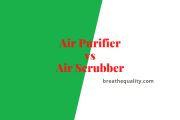Dust mites are microscopic creatures. They are related to the spider. They flourish in warm, humid weather and are commonly found across the world. Dust mites feed on dead human and animal skin cells. Dust mites reproduce approximately every 3 weeks. The frequency of dust mites makes it easy for them to infest a home. Here are the most common, ideal environments for dust mites.
- Bedding
- Upholstered Furniture
- Carpeting
- Curtains and Drapes
Since these organisms are 0.25–0.3 millimeters in length, which is invisible to the naked eye, they float into the air when anyone vacuums, walks on carpet, or disturbs bedding. Once in the air, they are easily inhaled, ingested, and trapped on your body. It feeds on dead human skin flakes, which peel off in the amount of 1.5 g daily. As a result, mites produce feces up to 30 m in length that are coated in special proteins. When inhaling them or contacting them, many people will get severe allergic reactions.
Related post: Best air purifier for dust mites.
Although some people do not have a reaction to dust mites and their feces, as many as 20 million people in the United States suffer from allergies or asthma; so many have asked: Can you get rid of dust mites, and if so, how?
Although some people do not have a reaction to dust mites and their feces, as many as 20 million people in the United States suffer from allergies or asthma; so many have asked: Can you get rid of dust mites, and if so, how?
Using an air purifier to help capture these airborne dust mites is the most recommended solution. But you may want to know, “Do air purifiers get rid of dust mites?” Together with Breathe Quality, we will find out how.
Note: If you need answers to common questions about air purifiers, please read our air purifier FAQs.
Related posts
Do air purifiers get rid of dust mites?
An air purifier will help reduce the dust mite population. Air purifiers continuously refresh the air in your room to capture all of the dust, skin, and bacteria inside the room, which is what they feed off. Also, because True HEPA filters in air purifiers can delete pollutant particles down to 0.3 microns (which is much smaller than a normal dust mite), they will trap the dust mites inside easily.
The biggest difficulty when it comes to eliminating dust mites is the fact that their main food source never gets depleted. These little critters feed off the dead skin cells that we shed from our bodies on a daily basis—and this won’t ever stop.
List of the best air purifiers
- 1, Best Air Purifiers (Air Purifier Ranking List)
- 2, Best Air Purifiers for Allergies and Asthma
- 3, Best Air Purifiers for Bedroom
- 4, Best Air Purifiers for Baby
- 5, Best Air Purifiers for Smoke
- 6, Best Air Purifiers for Dust
- 7, Best Air Purifiers for Mold
- 8, Best Large Room Air Purifiers
- 9, Best Air Purifiers for Pets
- 10, Best Air Purifiers for Office
Beside using air purifiers to reduce the dust mites, we could use these surefire methods to kill the dust mites:
- Hot water (130°F or higher) kills mites.
- Humidity lowers to 40-50% is not a proper environment for dust mites.
- Extreme cold also kills dust mites. Put your small objects into plastic bags then put them into the fridge to destroy the mites.
- Rubbing alcohol kills household dust mites. Using some rubbing alcohol on a rag is a quick way to clean areas that have a lot of dust build up, like on light bulbs or electronics.
- Direct sunlight can kill these pests. Make sure your curtains are open for direct sunlight in all of your room.
- Dust mite aerosol sprays are also available to kill these mites. You can use these sprays directly on your bed and furniture. However, we don’t recommend this as a solution because the effects only last for 2 weeks, so it will be very expensive to buy lots of sprays to use in your entire home.
Dust Mite Allergies Symptoms
The dust in our homes consists of several components like pet dander, skin cells, pet and human hair, tiny fibers, bacteria, food particles, and dust mite parts and feces. A dust mite allergy includes an allergic reaction to dust mite particles, debris, and waste. While a dust mite is extremely small (it can only be viewed under a microscope), it can produce nearly 200 times its own weight in feces. The proteins in these feces work as allergy factors.
Symptoms of a dust mite allergy include:
- Runny nose
- Itchy eyes
- Watery or red eyes
- Sneezing
- Congestion of the nose
- Coughing
- Post nasal drip
- Pain and pressure in the face
- Itchy nose and throat
- Difficulty sleeping
- Swollen eyes
- Puffy, bluish skin under the eyes
- Rubbing of the nose, typically in children
If a dust mite allergy persists and triggers asthma, a person may also experience:
- Tightness or pain in the chest
- Trouble breathing
- Wheezing
- Coughing
Risk Factors
The probability of developing a dust mite allergy may be raised by the following risk factors:
- It can be heritable from your family
- Having been exposed to dust mites early in life may increase your chances of developing a dust mite allergy later
- Children are more likely to develop an allergy to dust mites
Rating Breathe Quality
-
Average ratings for this post



